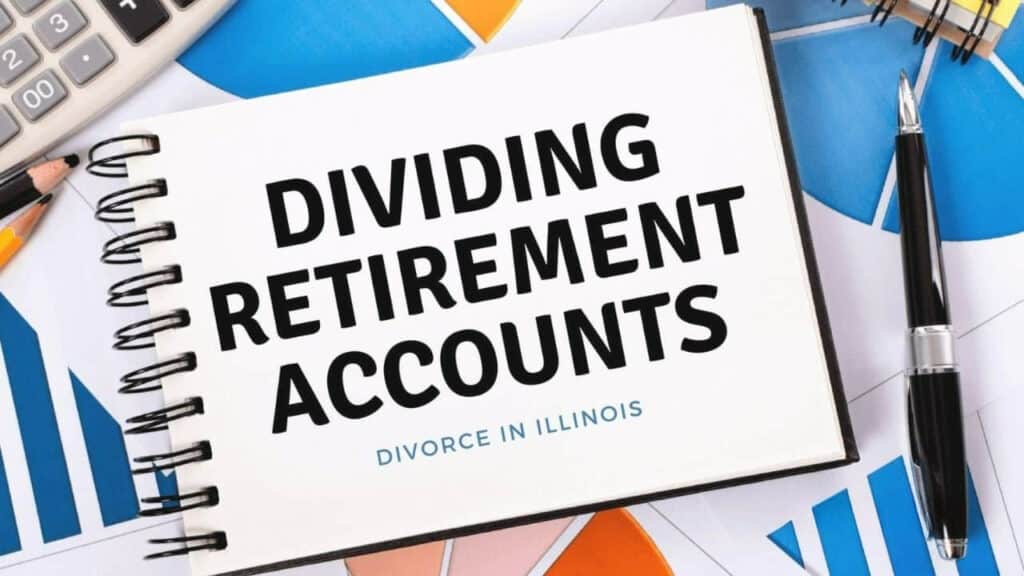Dividing retirement assets is one of the most critical financial aspects of divorce proceedings in Illinois. Because retirement accounts often make up a significant part of marital assets, dividing them can be legally complex. Without proper handling, mistakes in this process may cause tax penalties, financial insecurity, or unfair asset distribution.
In Illinois, retirement accounts are subject to equitable property distribution, meaning they are divided fairly but not always equally. Various factors, including the length of the marriage, each spouse’s financial contributions, and their future financial needs, influence the division process. Additionally, different types of retirement accounts, such as 401(k)s, IRAs, and pensions, require different legal and financial approaches.
This guide aims to help you understand how retirement accounts are divided in an Illinois divorce the role of Qualified Domestic Relations Orders (QDROs), and strategies for protecting your financial future. Whether you are preparing for a divorce or seeking clarity on retirement asset division, understanding your rights and options is crucial to ensuring a fair outcome.
Key Takeaways:
- Retirement accounts accumulated during the marriage are considered marital property and are subject to equitable distribution.
- Qualified Domestic Relations Orders (QDROs) are required to divide 401(k)s and pensions without tax penalties.
- Different types of retirement accounts (e.g., 401(k)s, IRAs, pensions) have different legal and financial implications.
- Strategic planning through legal agreements such as prenuptial/postnuptial agreements can protect retirement assets.
- Tax consequences should be carefully managed to avoid unnecessary financial losses.
Marital vs. Non-Marital Retirement Assets
Illinois follows the principle of equitable distribution, meaning marital assets—including retirement accounts—are divided fairly, though not always equally. Retirement savings accumulated during the marriage are generally considered marital property and subject to division. However, contributions made before the marriage or after separation are classified as non-marital property and remain with the original account holder.
Types of Retirement Accounts in Divorce
Each type of retirement account comes with its own set of rules and legal requirements when it comes to asset division in a divorce. Below, we will break down the most common types of retirement accounts and how Illinois courts typically handle them.
401(k) Accounts
A 401(k) is a tax-advantaged retirement savings plan offered by many employers. These accounts are commonly called “defined contribution plans” as you know each month what you are contributing towards your retirement in these accounts. In a divorce, the portion of the 401(k) that is accumulated during the marriage is called the marital portion and is considered marital property. Marital property is subject to equitable division in a divorce.
A document called a Qualified Domestic Relations Order (QDRO) is the crucial document in dividing a 401(k). This order allows the retirement plan administrator to distribute a portion of the account to the non-earning spouse without either party incurring penalties or taxes. After the QDRO is approved by the plan and entered by the court, the non-earning spouse’s share of the 401(k) gets rolled over into an IRA account in their own individual name. The non-earning spouse can then decide to keep the funds in that IRA, roll-over the IRA funds into a different IRA, invest the funds in other ways (which could have tax consequences), or they can opt for a cash distribution (which may have tax consequences if taken early).
IRA Accounts (Traditional and Roth IRAs)
An Individual Retirement Account (IRA) is another common retirement vehicle. Unlike a 401(k), a QDRO is not usually required to divide an IRA in a divorce. Instead, the account can be divided through a transfer incident to divorce, which allows the funds to be transferred without tax penalties. This transfer can be completed by filling out transfer forms with the IRA so that the funds being transferred to the non-earning spouse can be put into a separate IRA in their own individual name. Just like with a 401(k) plan, the funds that get divided in a divorce are any funds that were accumulated during the marriage, or the marital portion.
It’s important to note that if either spouse withdraws funds from the IRA rather than transferring them to a new account, they could face taxes and penalties, particularly if they are under the age of 59 ½. Both Traditional IRAs and Roth IRAs can be divided, but they have different tax implications if you withdraw funds.
Pensions
Pensions can be complex assets to divide because they involve future payouts rather than a present-day balance like a 401(k) or an IRA. Pension benefits are commonly called “defined benefit plans”. The non-earning spouse will get a monthly payment from the pension plan but won’t know the total benefits they will receive until their spouse retires an. Illinois law considers the portion of the pension earned during the marriage marital property. The marital portion of the pension is subject to equitable division.
A QDRO (or similar legal order) divides pensions and ensures the non-earning spouse receives a percentage of the pension benefits upon the pension-holder’s retirement. Special rules apply to military pensions and government pensions, making it even more important to have an experienced attorney guide you through the process. For a more detailed breakdown of pensions, visit our blog on Pension Division in Divorce.

Other Retirement Accounts
Some other retirement accounts that may be involved in divorce cases include:
- 403(b) accounts (for public employees)
- Thrift Savings Plans (TSPs) (for federal employees)
- SEP IRAs (Simplified Employee Pensions)
Each of these accounts has unique rules for division and may or may not require a QDRO, depending on the type of account and the institution managing it.
How Retirement Accounts Are Divided
The division of retirement accounts in Illinois divorces varies based on the type of account and the couple’s circumstances. Courts evaluate several factors to ensure a fair and just distribution of assets:
- The length of the marriage – Longer marriages typically lead to a more equal division of assets, including retirement funds.
- Each spouse’s financial and non-financial contributions – Contributions such as earnings, homemaking, and caregiving are considered.
- Future earning potential and financial needs – If one spouse has significantly lower earning potential, they may require additional retirement assets.
- Age and health of both parties – A spouse nearing retirement age with fewer earning years ahead may receive a larger share.
- The standard of living established during the marriage – If one spouse was financially dependent, the court may allocate a greater portion of retirement assets to maintain stability.
Example: Division of a 401(k) in Divorce
Sarah and Tom have been married for 20 years, during which Tom contributed to a 401(k) provided by his employer. At the time of their divorce, Tom’s 401(k) has a balance of $500,000, with $400,000 contributed during the marriage and $100,000 from before the marriage. Since the portion accumulated during the marriage is marital property, Sarah is entitled to a fair share of the $400,000. A QDRO is required to legally transfer Sarah’s portion without tax penalties.
Related Article: Navigating the Division of Retirement Accounts in High Asset Divorce
Methods of Dividing Retirement Accounts
1. Direct Transfer or Rollover
For IRAs, the division can be handled through a transfer incident to divorce, allowing for tax-free movement of funds between spouses. The recipient spouse can then reinvest the assets in their own IRA.
2. Qualified Domestic Relations Order (QDRO)
For employer-sponsored plans such as 401(k)s and pensions, a QDRO is required. This legal order ensures that funds are distributed directly to the receiving spouse without incurring penalties. The recipient may roll over the funds into their own qualified plan or receive payments directly.
3. Pension Plan Division
Unlike defined contribution plans, pensions require special handling. The court may award a percentage of future payments to the non-employee spouse, or the pension may be valued and offset with other marital assets. Because pensions provide income in the future, they must be assigned a ‘present value’ to determine their worth today. This calculation takes into account factors like the employee’s age, expected retirement date, and potential payout amount.
4. Buyout Agreement
The spouse retaining the retirement account may offer a lump-sum payment or alternative asset (such as home equity) to the other spouse in exchange for keeping full ownership of the retirement funds.
Because each method carries distinct tax and financial implications, consulting legal and financial professionals helps prevent unnecessary losses.
Tax Considerations When Dividing Retirement Accounts
Tax Implications of Dividing Retirement Accounts
Improper handling of retirement account division in divorce can create significant tax consequences. Here’s what to consider:
- 401(k)s and Pensions: A QDRO allows tax-free transfers. However, if the non-earning spouse takes a lump sum instead of rolling funds into another retirement account, they will owe income taxes. Withdrawals before age 59 ½ may also trigger early withdrawal penalties.
- IRA Accounts: A transfer incident to divorce remains tax-free as long as you roll the funds into a new IRA or retirement account. However, cashing out funds can result in taxes and penalties.
- Roth IRAs: Roth IRA withdrawals are typically tax-free in retirement since contributions are after-tax. But withdrawing funds before reaching age 59 ½ could lead to penalties.
Important Note: Tax laws are complex, and everyone’s situation is different. This is just a general overview. To get advice tailored to your specific circumstances, always consult with a qualified tax advisor or CPA. For more information, you can check out IRS Publication 504 (Divorced or Separated Individuals) on the IRS website.
The Role of a Qualified Domestic Relations Order (QDRO)
A Qualified Domestic Relations Order (QDRO) is a court order required to divide certain retirement accounts, such as 401(k) plans and pensions, without triggering early withdrawal penalties. The QDRO allows the receiving spouse to receive their portion of the retirement funds without tax consequences if the funds are rolled into another retirement account. Without a QDRO, withdrawing funds from a retirement account could result in substantial penalties and taxes. Drafting a QDRO requires specialized knowledge of retirement plan rules and regulations. It’s essential to work with an attorney who has significant experience in this area to ensure the QDRO is valid and enforceable.
Legal Strategies for Protecting Retirement Assets
To protect retirement savings, spouses may consider legal agreements such as:
- Prenuptial Agreements – a prenuptial agreement outline asset division before marriage.
- Postnuptial Agreements – Define asset ownership during marriage.
- Mediation or Collaborative Divorce – Alternative dispute resolution methods that allow for negotiation and asset protection.
These agreements can help secure financial stability in the event of a divorce and minimize legal disputes over retirement assets. We understand that dividing retirement assets can be a complex and stressful process. Our goal is to help you navigate this process with confidence and protect your financial future.
Download Our Guide to Property Division in Divorce
Frequently Asked Questions (FAQs) About Dividing Retirement Accounts in Divorce
Are retirement accounts always split 50/50 in an Illinois divorce?
No, Illinois follows equitable distribution, which means the court divides assets fairly, not necessarily equally. Factors such as the length of the marriage, each spouse’s financial situation, and future earning potential impact how retirement accounts are divided.
Do I need a QDRO to split all retirement accounts?
A QDRO (Qualified Domestic Relations Order) is required for dividing certain employer-sponsored retirement plans like 401(k)s and pensions. However, IRAs do not require a QDRO and are typically divided through a transfer incident to divorce to ensure tax-free movement of funds.
Can I cash out my share of my spouse’s retirement account immediately?
While possible, cashing out can result in income tax liabilities and early withdrawal penalties. Many recipients opt to roll over their portion into an IRA or another retirement account to defer taxation and continue saving for retirement.
What happens if my spouse contributed to a retirement account before our marriage?
Any retirement funds accumulated before the marriage are typically considered non-marital property and remain with the original owner. However, contributions made during the marriage, along with any growth on those contributions, may be subject to division.
How can I protect my retirement savings in a divorce?
Legal agreements such as prenuptial and postnuptial agreements can specify how retirement savings will be handled in the event of a divorce. Additionally, strategic negotiation during divorce proceedings can help ensure a fair division of assets.
Final Thoughts and Next Steps
Protect Your Retirement Assets With Experienced Legal Guidance
Dividing retirement accounts in an Illinois divorce requires careful planning and legal guidance. The family law attorneys at Anderson Boback & Marshall have extensive experience handling complex divorce cases that involve and retirement asset division. We are committed to ensuring you receive a fair settlement while safeguarding your long-term financial stability. Missteps can result in lost assets, unnecessary tax burdens, or long-term financial hardship. It is crucial to achieve a fair distribution while addressing legal considerations and financial stability.
Next Steps
- If you’re going through a divorce and have concerns about your retirement assets, schedule a consultation with an Illinois divorce attorney experienced in high-asset divorce cases.
- Work with a financial advisor to understand the tax implications and long-term effects of retirement asset division.
- Consider alternative dispute resolution methods, such as mediation, to negotiate a fair division of assets without prolonged litigation.
Contact us today to schedule a consultation and take the first step toward securing your financial future.















